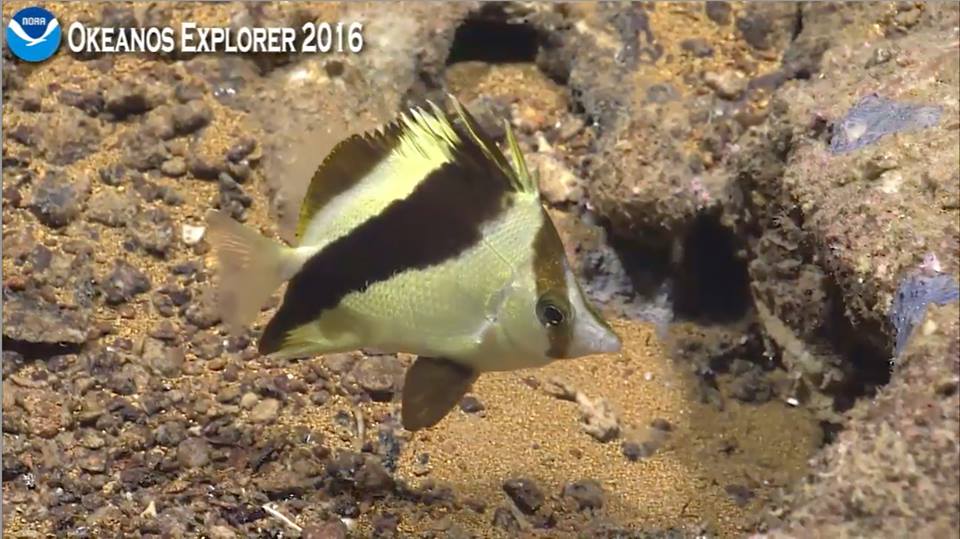
Prognathods guyotensis, the Guyote Butterflyfish. Photo credit: NOAA Okeanos Explorer 2016.
The NOAA Okeanos Explorer‘s live feed broadcast has resulted in an amazing display of unity amongst aquarists and scientists from all corners of the globe, as they gather together as a single entity to appreciate what the deep reefs of Guam and the Marianas have to offer. Over the last couple of days, we’ve seen an incredible array of fish, many of which are completely new to science. Throughout this broadcast, the discerning ichthyophile may have noticed endemic species from other regions culminating in the Marianas. This isn’t all that surprising, since Guam and the Marianas are at the cross roads between Hawaii, Micronesia, and Japan. Throughout the broadcast we see species from each of these regions appearing together in harmony – Roa excelsa and Grammatonotus macrophthalmus from Hawaii, Odontanthias sp. and Grammatonotus sp. from Micronesia, and Odontanthias unimaculatus from Japan, for example.
However, the appearance of this superstar deity could not have been anticipated even by the saltiest of fish geeks (Although as an act of good luck, I did wear a T-shirt depicting this species in hopes of meeting one in the dive feed. Who would have thought it would actually happen!).

Prognathods guyotensis, the Guyote Butterflyfish. Photo credit: NOAA Okeanos Explorer 2016.
Prognathodes guyotensis is truly one of the most enigmatic and elusive member of the entire butterflyfish family, with no more than five specimens known only from deepwater trawls and submersible videos. This species was first known in 1982 on the basis of three specimens collected from a trawling operation on the top of a guyot at 342m (>1000ft) located in the Kyushu-Palau Ridge, on the Philippine plate (Nalbant, 1991). It was subsequently described by Yamamoto and Tameka as Chaetodon guyotensis, the specific epithet alluding to the guyot from which it came.

Prognathods guyotensis, the Guyote Butterflyfish. Photo credit: NOAA Okeanos Explorer 2016.
Six years later in 1988, Randall and DeBruin obtained a fourth specimen off of Maldives, and subsequently moved the species into the genus Prognathodes. Nalbant, on the basis of morphology and meristics, disagreed with this generic placement, and erected a new genus Peterscottia for guyotensis. He also considered the Maldivian representative to be allopatric and specifically distinct from the Pacific Ocean representative, and alluded the Indian Ocean specimen to be of a separate species. Today, Peterscottia is a junior synonym, and guyotensis remains in Prognathodes; although this is quite likely subjected to future changes.

Prognathods guyotensis, the Guyote Butterflyfish. Photo credit: NOAA Okeanos Explorer 2016.
The photos shown here (captured at 270 m) are some of the best images of the species anywhere today, surpassing the few blurry ones that were used for print publications many years ago. For those who were tuning in, the feed was perhaps also the first time P. guyotensis has been captured on video and made available to the public. This truly is one of the last great frontiers of the butterflyfish family, and it’s really exciting to have witnessed its appearance, live, on camera.
“NOAA Ship Okeanos Explorer is operating on Fiji time (GMT +12) during the 2016 Deepwater Exploration of the Marianas expedition. Daily daytime remotely operated vehicle (ROV) dives are planned, with ROV deployment at approximately 0830 and ROV recovery at approximately 1630 Fiji time most days.”










0 Comments